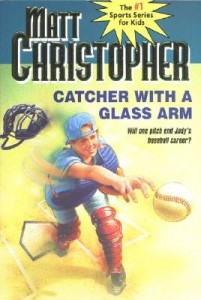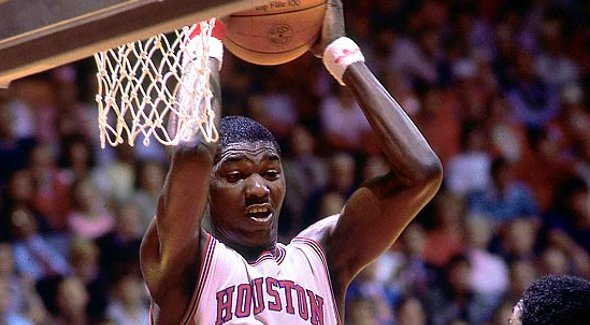On the Court . . .
I bring all this up for two reasons:
1) Matt Christopher’s writing style is well-established, and people familiar with his work know what it feels like when he tells the story of fictional sporting events.
2) On the Court with . . . Hakeem Olajuwon reads exactlylike a Matt Christopher work of fiction, except all the people are real, and we have every reason to believe that events that were at least somewhat like the events mentioned in the book all really happened.
After procuring it from my friend’s gag-gift stocking, I actually read On the Court with . . . Hakeem Olajuwon in one sitting – took me about two hours or so. But it was so comfortable, it felt so familiar – it was even in the same comforting medium-sized serif font I immediately recognized from my own old Matt Christopher books.
You would think the story of a real person would require stylistic departure from the description of fictional people, but this is not how Matt Christopher’s writing works. If you wanted to be dismissive, you could say that Matt Christopher is primarily concerned with the surfaces of things and doesn’t really plumb their depths. This would certainly be true, but probably also unnecessary. If you wanted to be more positive, you could say that maybe there is a way the play of sport already exists in a form of discourse that communicates with reality and with fiction equally well, and as long as the sports story is solidly grounded in sports themselves – sporting events, played with a sense of fun and a drive to win – the experience of reality is very similar to the experience of fiction.
After all, there are only so many things that can happen in a basketball game, and yet the games each lend themselves to their own accessible narratives. This is part of why sport is such a phenomenal entertainment. It’s less that sport requires story to sustain it, or that sport has an aspect of story – if I were building a classic Greco-Roman pantheon of cultural, allegorical demigods, I would case sport and story as close brothers or sisters that share much of the same body, speaking with the same mouth, but from different faces. Sport is more than just fake war, and sportswriting is more than just forcing narrative on some actions of chance. It’s all part and parcel of play.

It's not like Vulcan forged his glass arm, after all.
On one hand, war is real and sports are false.
On the other, the consequences of sports are very real. They have their own rules and lessons, but the victory and defeat of sports matter to people just as much, if not more so, than the victory and defeat of war. So, on this second hand, sports accomplishes most of the good stuff war accomplishes and almost none of the bad stuff, making a much better, more legitimate human endeavor and a smarter way in general to spend your time and energy.
When reading passages like the following:
NC State took advantage of the strategy. They forced a couple of turnovers and tied the game at 52.
With only seconds remaining, the Wolfpack looked to take the last shot. But the Cougars dug in and kept them away from the basket.
Down low, Hakeem watched the shot arc toward the basket. He saw the ball was going to fall short. He knew he could easily catch it, but was afraid the referees might call him for goaltending, giving the Wolfpack two points and the game.
The ball did fall short. But as Olajuwon reached for the rebound, NC State forward Lorenzo Charles snuck in, grabbed it, and dunked the ball just as time expired. Houston lost, 54-52!”
It’s interesting how literally and straightforwardly Matt Christopher describes the action while still forming pleasant sentences and keeping a narrative flow and tempo to the passage. The basic facts of the game, which would be excluded from most serious considerations of form and meaning, do most of the job of telling most Matt Christopher stories.
My favorite instance of this in On the Court with . . . Hakeem Olajuwon is how Matt Christopher uses the Dream Shake in the piece. He describes the training Hakeem underwent to first learn and perfect his spinning fadeaway jumper in the summer after his freshman year at college, and then trots it out as a key shot in a very important game about twelve years later.
Now, of course Hakeem Olajuwon used the Dream Shake more than a few times in his life. It was his signature moveset in every game he played from the mid-80s through the end of his career, and the man played a lot of games. But Matt Christopher picks and chooses when to talk about it in order to provide the narrative with shape. So, there is method to the madness.
So, when you read On the Court with . . . Hakeem Olajuwon, you read about 34 years of a man’s life mostly in the form of a POV play-by-play of a number of basketball games, where things like which hand he is dribbling with at any given time or the specific person guarding him are important to how the book works.

I’ve never been able to figure out if I read Challenge at Second Base because I played the position, or vice-versa.
Hakeem Olajuwon also had his own brand of sneakers, which were of note because they were really cheap juxtaposed to Nike’s sneakers. As such, I found myself wearing them when I played basketball as a kid. Way to be, Hakeem Olajuwon!
I just recently found my copy of “On the Ice with… Mario Lemieux”. I think it’s what made me a Pens fan.